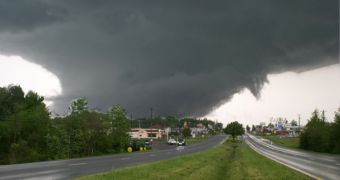On April 27, 2011, a series of tornadoes hit the state of Alabama, and other states in the southeastern parts of the United States, with tremendous force, producing numerous casualties and enormous damages. Now, a team of experts is embarking on an expedition to understand why that happened.
University of Alabama in Huntsville (UAH) experts are spearheading the effort. They are putting together a comprehensive picture of what happened, using information from numerous sources.
They are primarily analyzing radar measurements that were collected that day. These data are merged with storm surveys and other sources, to produce a clear picture of how the atmosphere looked like when the tornadoes hit.
One of the most important questions that the new study needs to answer is why were the storms so powerful. A secondary objective is learning from this lesson, so that tornado warning systems become even more effective in the future.
For the research, the US National Science Foundation (NSF) unlocked one of its Rapid Response Research (RAPID) grants. These funds are kept in reserve, and used in order to enable a fast response to events such as tornadoes, tsunamis, heat waves, volcanic eruptions, oil spills and so on.
For this particular study, the grant also covers investigating the psychology and sociology of storm warnings, officials from the NSF say. Graduates students from UAH and the University of Oklahoma are involved in the study .
The volunteers are conducting interviews in the affected areas. Their goal is to paint a picture of how people reacted to the numerous tornado warnings that were issued back in April. This might researchers a better view on how to change public announcements so that they become more persuasive.
“Heavily forested rolling terrain and limited public awareness may present unique challenges to tornado detection in this area and to widespread dissemination of and effective public response to severe weather warnings,” Brad Smull explains.
The expert holds an appointment as a program director at the NSF Division of Atmospheric and Geospace Sciences (DAGS). The Division funds the RAPID award the research team uses.
“One thing we're after is whether people are desensitized because the false alarm rate is so high, especially in areas where there are only countywide alerts,” concludes the leader of the UAH severe weather research team, Kevin Knupp.

 14 DAY TRIAL //
14 DAY TRIAL //